Abstract
The mechanism of the hypergastrinaemia associated with Helicobacter pylori infection is unknown. It may be an effect of the ammonia produced by the bacterium near the antral epithelial surface. We have examined the effect on serum gastrin of inhibiting H pylori urease activity with acetohydroxamic acid in six duodenal ulcer patients. On day 1 the fasted patients received placebo tablets at 8 am, a peptide meal at 10 am, and a 14C urea breath test at 11.30 am. The next day 750 mg acetohydroxamic acid was administered orally in place of the placebo. The median (range) 30 minute breath test value (dose/mmol CO2 X kg body wt X 100) was 152 (111-335) on day 1, but only 22 (14-95) the next day (p less than 0.03). Further studies performed in one subject confirmed that acetohydroxamic acid lowered the ammonium concentration and raised the urea concentration in gastric juice. The inhibition of urease activity and ammonia production did not result in a fall in the basal gastrin concentration or in the median integrated gastrin response to the peptide meal, which was 78 ng/1.h (range 21-222) on day 1 and 79 ng/1.h (33-207) the next day. Ten days after acetohydroxamic acid, the urea breath test values were similar to those before treatment. This study shows that the raised gastrin concentration in patients with H pylori infection is not directly related to the organism's urease activity. It also shows that temporary suppression of H pylori urease activity does not clear the infection.
Full text
PDF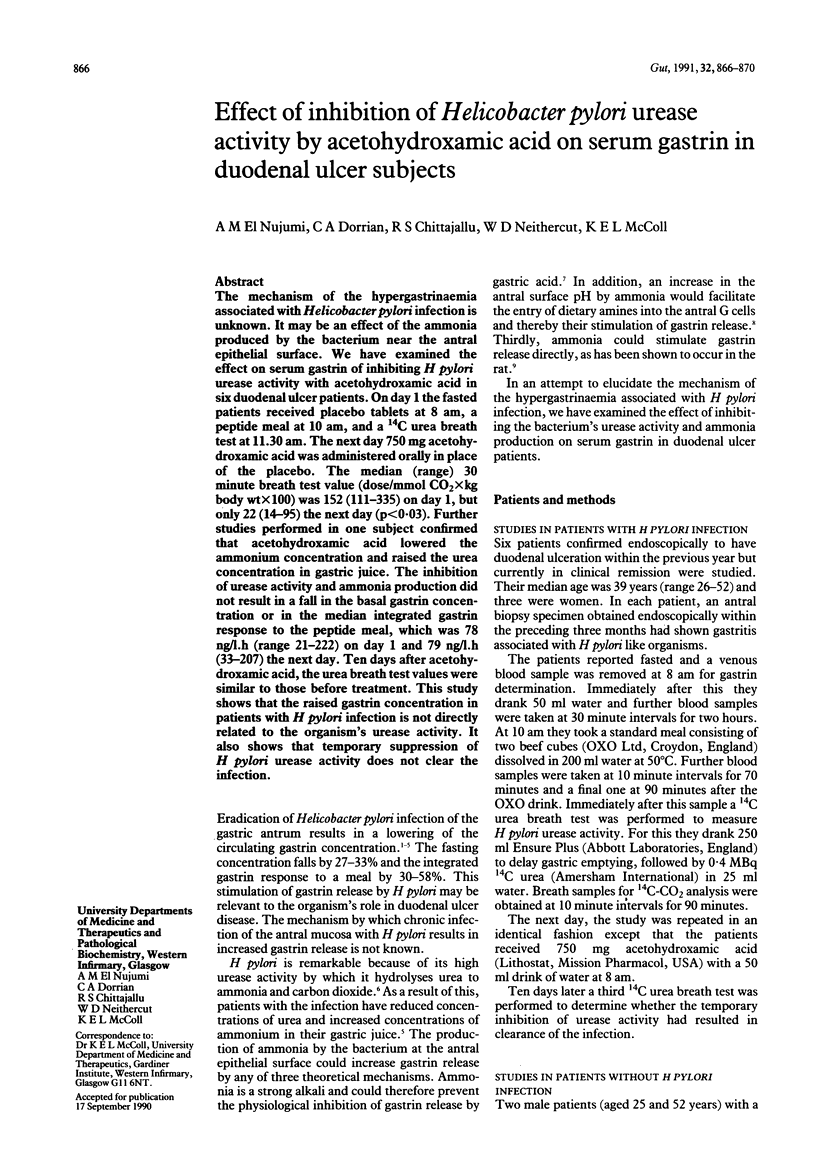
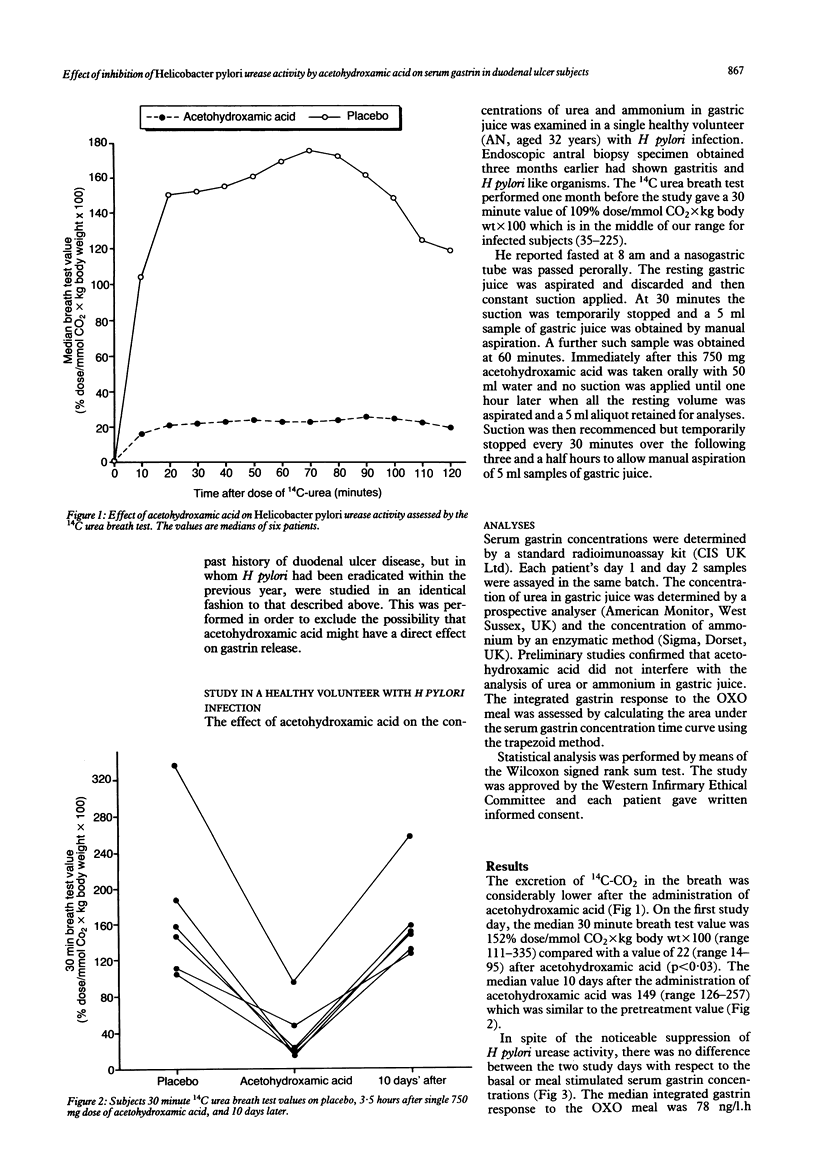
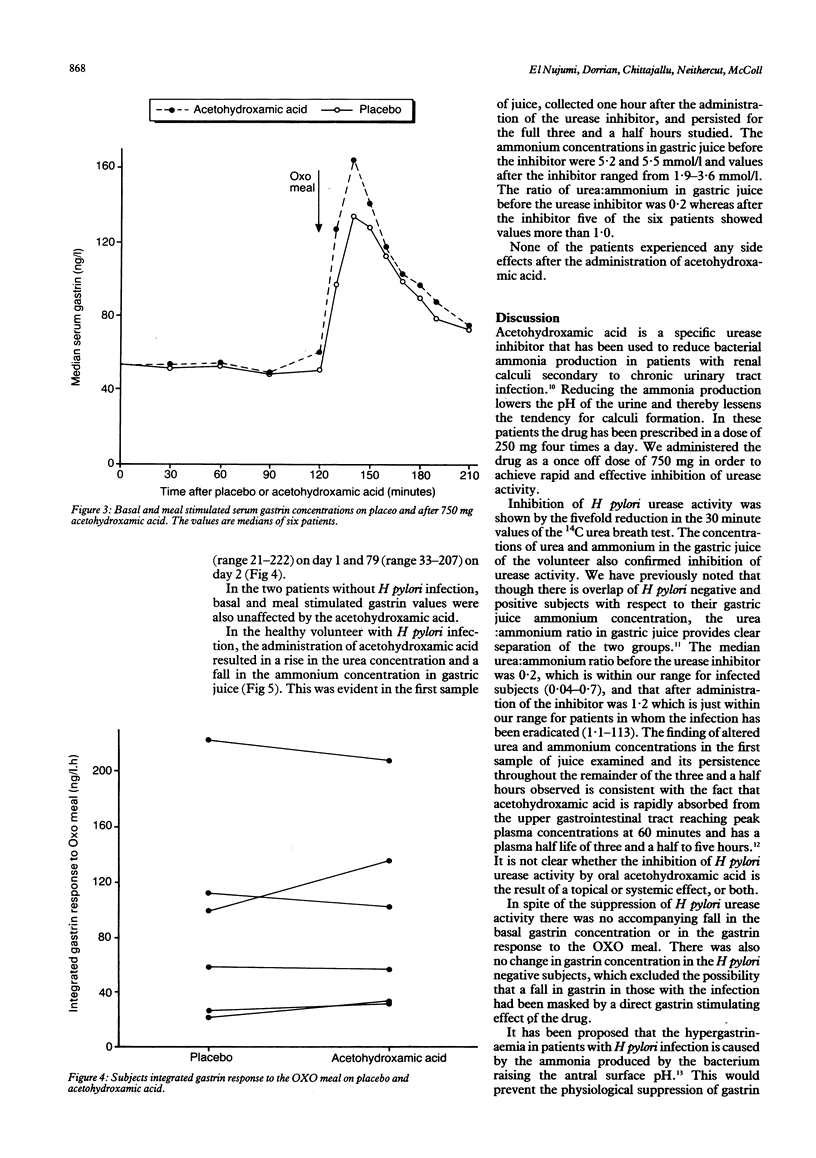
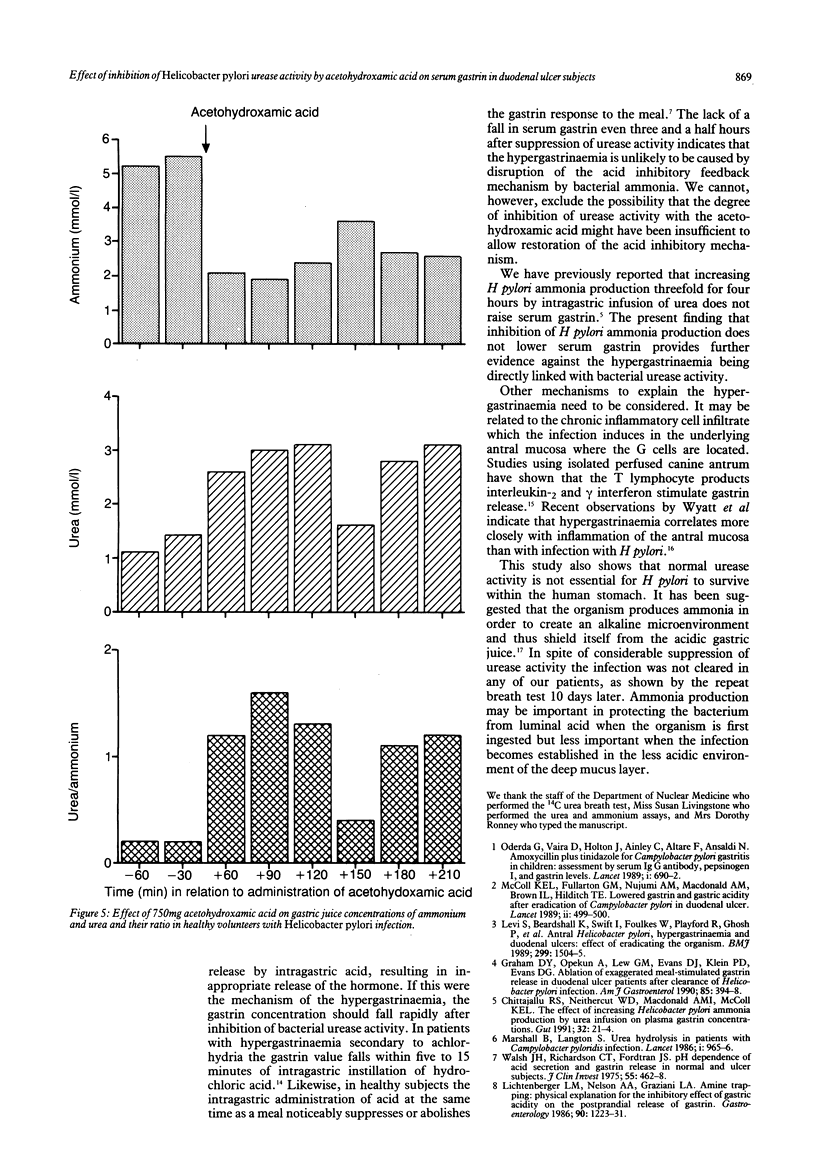
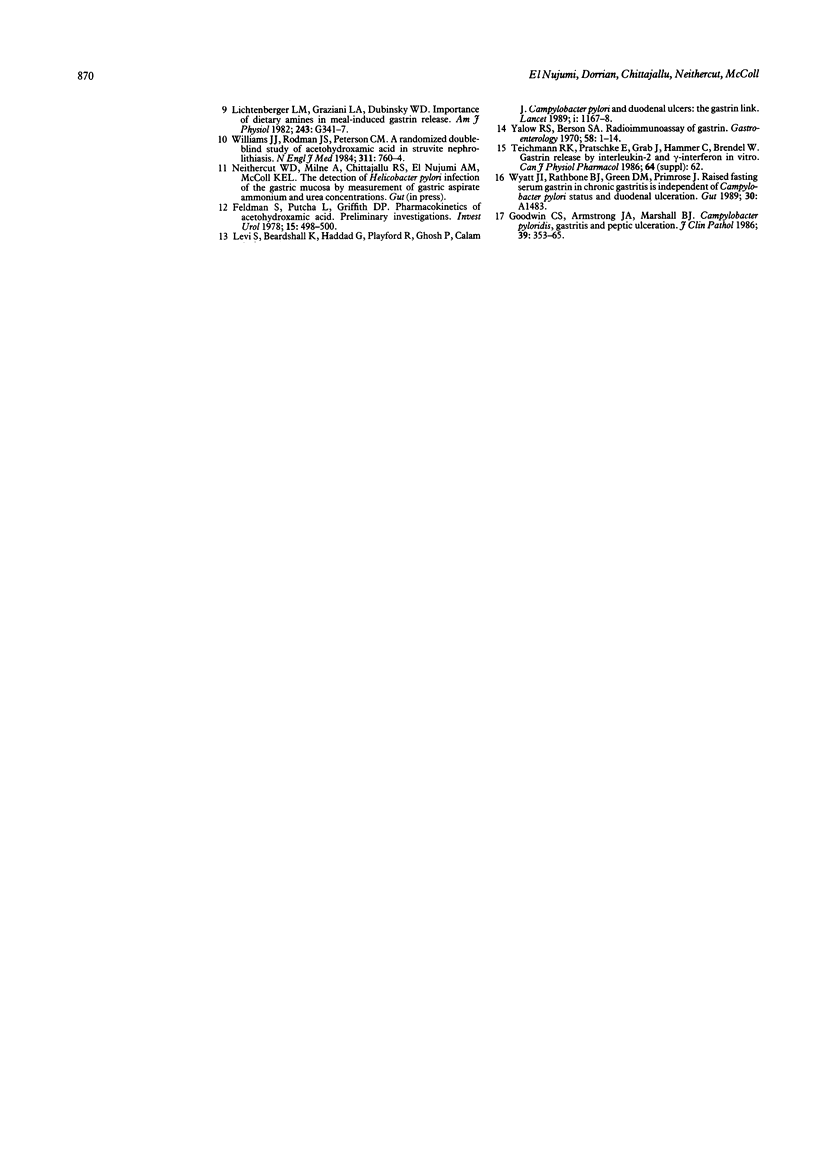
Selected References
These references are in PubMed. This may not be the complete list of references from this article.
- Chittajallu R. S., Neithercut W. D., Macdonald A. M., McColl K. E. Effect of increasing Helicobacter pylori ammonia production by urea infusion on plasma gastrin concentrations. Gut. 1991 Jan;32(1):21–24. doi: 10.1136/gut.32.1.21. [DOI] [PMC free article] [PubMed] [Google Scholar]
- Feldman S., Putcha L., Griffith D. P. Pharmacokinetics of acetohydroxamic acid. Preliminary investigations. Invest Urol. 1978 May;15(6):498–501. [PubMed] [Google Scholar]
- Goodwin C. S., Armstrong J. A., Marshall B. J. Campylobacter pyloridis, gastritis, and peptic ulceration. J Clin Pathol. 1986 Apr;39(4):353–365. doi: 10.1136/jcp.39.4.353. [DOI] [PMC free article] [PubMed] [Google Scholar]
- Graham D. Y., Opekun A., Lew G. M., Evans D. J., Jr, Klein P. D., Evans D. G. Ablation of exaggerated meal-stimulated gastrin release in duodenal ulcer patients after clearance of Helicobacter (Campylobacter) pylori infection. Am J Gastroenterol. 1990 Apr;85(4):394–398. [PubMed] [Google Scholar]
- Levi S., Beardshall K., Haddad G., Playford R., Ghosh P., Calam J. Campylobacter pylori and duodenal ulcers: the gastrin link. Lancet. 1989 May 27;1(8648):1167–1168. doi: 10.1016/s0140-6736(89)92752-9. [DOI] [PubMed] [Google Scholar]
- Levi S., Beardshall K., Swift I., Foulkes W., Playford R., Ghosh P., Calam J. Antral Helicobacter pylori, hypergastrinaemia, and duodenal ulcers: effect of eradicating the organism. BMJ. 1989 Dec 16;299(6714):1504–1505. doi: 10.1136/bmj.299.6714.1504. [DOI] [PMC free article] [PubMed] [Google Scholar]
- Lichtenberger L. M., Graziani L. A., Dubinsky W. P. Importance of dietary amines in meal-induced gastrin release. Am J Physiol. 1982 Nov;243(5):G341–G347. doi: 10.1152/ajpgi.1982.243.5.G341. [DOI] [PubMed] [Google Scholar]
- Lichtenberger L. M., Nelson A. A., Graziani L. A. Amine trapping: physical explanation for the inhibitory effect of gastric acidity on the postprandial release of gastrin. Studies on rats and dogs. Gastroenterology. 1986 May;90(5 Pt 1):1223–1231. doi: 10.1016/0016-5085(86)90389-6. [DOI] [PubMed] [Google Scholar]
- Marshall B. J., Langton S. R. Urea hydrolysis in patients with Campylobacter pyloridis infection. Lancet. 1986 Apr 26;1(8487):965–966. doi: 10.1016/s0140-6736(86)91060-3. [DOI] [PubMed] [Google Scholar]
- McColl K. E., Fullarton G. M., el Nujumi A. M., Macdonald A. M., Brown I. L., Hilditch T. E. Lowered gastrin and gastric acidity after eradication of Campylobacter pylori in duodenal ulcer. Lancet. 1989 Aug 26;2(8661):499–500. doi: 10.1016/s0140-6736(89)92105-3. [DOI] [PubMed] [Google Scholar]
- Oderda G., Vaira D., Holton J., Ainley C., Altare F., Ansaldi N. Amoxycillin plus tinidazole for Campylobacter pylori gastritis in children: assessment by serum IgG antibody, pepsinogen I, and gastrin levels. Lancet. 1989 Apr 1;1(8640):690–692. doi: 10.1016/s0140-6736(89)92206-x. [DOI] [PubMed] [Google Scholar]
- Walsh J. H., Richardson C. T., Fordtran J. S. pH dependence of acid secretion and gastrin release in normal and ulcer subjects. J Clin Invest. 1975 Mar;55(3):462–468. doi: 10.1172/JCI107952. [DOI] [PMC free article] [PubMed] [Google Scholar]
- Williams J. J., Rodman J. S., Peterson C. M. A randomized double-blind study of acetohydroxamic acid in struvite nephrolithiasis. N Engl J Med. 1984 Sep 20;311(12):760–764. doi: 10.1056/NEJM198409203111203. [DOI] [PubMed] [Google Scholar]
- Wilson D. R., Honrath U., Sonnenberg H. Effect of acetylcholine and secretin on medullary collecting duct function in the rat. Can J Physiol Pharmacol. 1986 Jan;64(1):62–65. doi: 10.1139/y86-009. [DOI] [PubMed] [Google Scholar]
- Yalow R. S., Berson S. A. Radioimmunoassay of gastrin. Gastroenterology. 1970 Jan;58(1):1–14. [PubMed] [Google Scholar]


